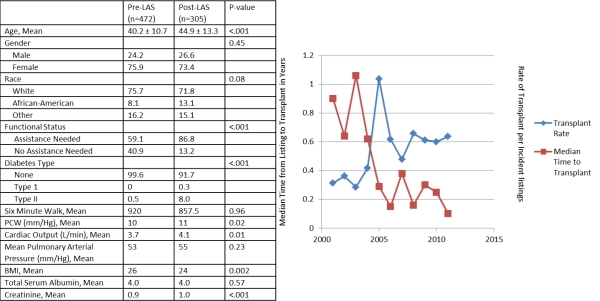Epidemiologic Change in Pulmonary Hypertension Patients Referred for Lung Transplantation Post Lung Allocation Score Implementation
1Comprehensive Transplant Institute, University of Alabama at Birmingham, Birmingham, AL
2Pulmonary Medicine, Cleveland Clinic Foundation, Cleveland, OH.
Meeting: 2015 American Transplant Congress
Abstract number: B210
Keywords: Lung transplantation, Pulmonary hypertension
Session Information
Session Name: Poster Session B: Lung- All Topics
Session Type: Poster Session
Date: Sunday, May 3, 2015
Session Time: 5:30pm-6:30pm
 Presentation Time: 5:30pm-6:30pm
Presentation Time: 5:30pm-6:30pm
Location: Exhibit Hall E
Introduction: The lung allocation score (LAS) was designed and implemented in May 2005 to account for various measures of a candidate's health in an attempt to equitably distribute organs to those who would best benefit from transplantation. Transplant referral practices for patients with pulmonary hypertension have changed following implementation of the LAS.
Methods: Adult lung transplant candidates listed from 2000-2011 with pulmonary hypertension were identified from the SRTR database (n=777). Candidates were classified as listed pre-LAS (2000-2005) or post-LAS (2006 and later). Demographics and clinical factors were compared by LAS implementation using chi-square or Wilcoxon rank sum tests. Median time to transplant by LAS era was analyzed using Wilcoxon rank sum.
Results: Following LAS implementation, the pulmonary hypertension population listed for transplant were older (40.2 yrs vs. 44.9, p<.001). Frequency of Type II Diabetes increased between pre-LAS and post-LAS eras (0.3% vs. 8.0%, p<.001), as did percent of candidates needing assistance with daily activities (59.1% vs. 86.8%, p<.001) (Table). Median time to transplant and waitlist mortality have decreased, while transplant rate has increased in the pulmonary hypertension population over the eleven year period (Figure). 
Conclusions: LAS implementation is correlated with changing demographics of the listed pulmonary hypertension population and changing median transplant time, transplant rate, and waitlist mortality rate. Future research should focus on survival rates in this population post-transplant.
To cite this abstract in AMA style:
Loyaga-Rendon R, Shelton B, Reed R, Tallaj J, Diaz-Guzman E, Heresi G, Locke J. Epidemiologic Change in Pulmonary Hypertension Patients Referred for Lung Transplantation Post Lung Allocation Score Implementation [abstract]. Am J Transplant. 2015; 15 (suppl 3). https://atcmeetingabstracts.com/abstract/epidemiologic-change-in-pulmonary-hypertension-patients-referred-for-lung-transplantation-post-lung-allocation-score-implementation/. Accessed December 24, 2025.« Back to 2015 American Transplant Congress
